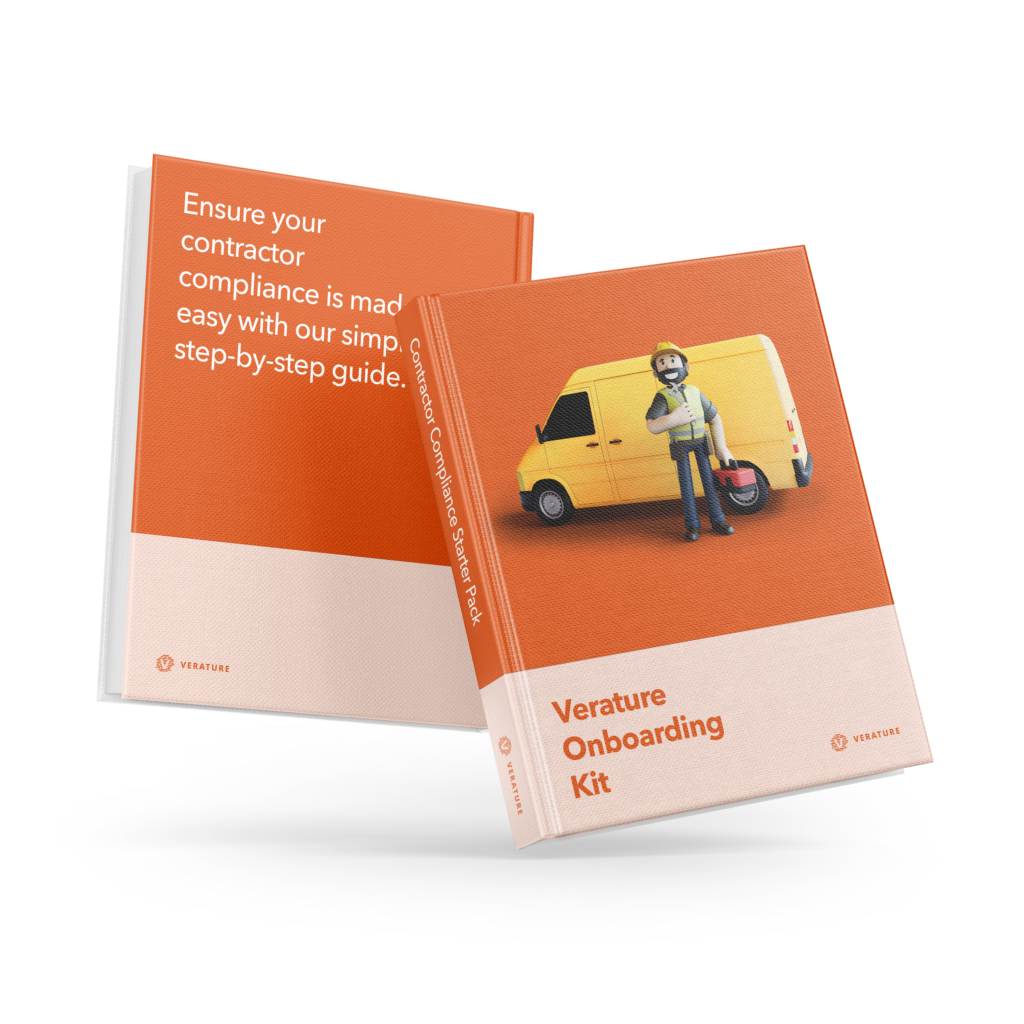- Why Verature?Find out why Verature is the best system for continuous contractor compliance.
- Arrive, Work & Stay Safe
- Removes Paper & Spreadsheets
- Tracks Key Contractors
- Instant 360 Visibility
- Contractor Management Dashboards
- Why Contractor Management Software
- Our Customer Reviews
- Pricing
We don’t hide behind fancy sales teams before we tell you, our prices.- Clients
See who we are working with and what they have to say about Verature.- Resources
Check out our blog, useful guides, whitepapers and product videos.- Prequalification and Induction Guide
- Contractor Compliance Guide
- Mini-Audit your Permit to Work System
- Health and Safety Audit Checklist
- Resource Library
- Blog
Book a demo
Elevate Your Contractor Management: Comprehensive Business Case + Free Download
We all know that presenting a well-structured and persuasive business case is like trying to convince your boss to let you bring your dog to work—challenging but totally worth it! If you’re looking to propose a centralised Contractor Management System (CMS) to your organisation, such as Verature, this example can serve as your secret weapon.
To make your life even easier, we’ve provided a downloadable copy so you can cut, copy and paste to your heart’s content. This business case is packed with everything you need to dazzle your stakeholders and get that much-needed approval.
By leveraging this template, you can effectively communicate the benefits of a CMS, ensuring your organisation achieves operational excellence, risk management, cost efficiency and sustainability. So, what are you waiting for? Download the full business case document here and get ready to impress your team with your newfound business case prowess.
Business Case for a Contractor Management System
Purpose
To propose implementing a centralised contractor management system within the organisation to enhance and streamline compliance and safety processes
Business Objectives
[Include direct links to your businesses’ key strategies or initiatives and any specific objectives pertaining to contractor management]
- Operational Excellence
• Efficiency Improvements: Streamline contractor management processes to reduce administrative overhead and improve operational efficiency.
• Quality Control: Ensure consistent quality of work by monitoring contractor performance and compliance with standards. Risk Management - Safety and Compliance
• Mitigate risks associated with non-compliance and safety incidents by ensuring all contractors adhere to regulations and safety protocols.
• Data Security: Protect sensitive contractor information through secure, cloud-based storage solutions. - Cost Management
• Cost Reduction: Lower administrative and operational costs through automated workflows and reduced manual processing.
• Resource Optimisation: Optimise resource allocation by tracking contractor availability and performance. - Strategic Growth
• Scalability: Implement a scalable system that can grow with the organisation, accommodating an increasing number of contractors and projects.
• Innovation: Foster innovation by leveraging data insights from the CMS to improve processes and decision-making. - Customer Satisfaction
• Service Quality: Enhance service quality by ensuring that contractors meet performance standards and deliver high-quality work.
• Timely Delivery: Improve project timelines by efficiently managing contractor schedules and availability. - Sustainability
• Long-term Viability: Support sustainable business practices that ensure the organisation’s long-term viability.
• Environmental Responsibility: Promote environmental responsibility by tracking and enforcing sustainable practices among contractors. - Stakeholder Engagement
• Internal Collaboration: Improve department collaboration by providing a centralised platform for contractor management.
• External Partnerships: Strengthen relationships with contractors and other external partners through transparent and efficient management processes. - Environmental and Social Governance (ESG) Impact
• Promote Sustainability and Ethical Practices: Implementing a Contractor Management System reduces the environmental footprint by digitising records and minimising paper usage. It enhances worker safety and well-being by ensuring compliance with safety regulations, reduces the risk of accidents and enforces fair labour practices. The system also maintains transparency and accountability in contractor activities, supporting ethical standards and regulatory compliance and fostering positive community relationships.
Current Situation
- Fragmented Data Management
• Shared Drives: Contractor information is stored in various folders on shared drives, leading to difficulties in accessing and managing data efficiently.
• Spreadsheets: Multiple spreadsheets are used to track contractor details, compliance status and project assignments, resulting in data silos and inconsistencies.
• Paper-Based Systems: Physical documents are used for contracts, permits and compliance records, making it challenging to maintain and retrieve information quickly. - Inefficiencies and Manual Processes
• Time-Consuming Tasks: Significant time is spent on manual data entry, updating records and searching for information across different systems.
• Human Error: High potential for errors in data entry and record-keeping due to manual processes.
• Duplication of Efforts: Repetitive tasks and data duplication occur frequently, leading to wasted resources and inefficiencies. - Compliance and Safety Risks
• Inconsistent Compliance Tracking: Difficulty in ensuring all contractors meet compliance requirements due to scattered and outdated records.
• Delayed Safety Updates: Slow dissemination of safety updates and protocols, increasing the risk of non-compliance and accidents. - Limited Visibility and Reporting
• Lack of Real-Time Data: Inability to access real-time information on contractor activities, compliance status and project progress.
• Ineffective Reporting: Challenges in generating comprehensive and accurate reports for audits, management reviews and regulatory compliance. - Communication Challenges
• Disjointed Communication: Communication with contractors is often fragmented, relying on emails, phone calls and paper documents, leading to miscommunication and delays.
• Coordination Issues: Difficulty in coordinating tasks and schedules between contractors and internal teams due to lack of a centralised system. - Security and Data Integrity Concerns
• Data Security Risks: Storing sensitive contractor information on shared drives and paper documents poses security risks.
• Data Integrity Issues: Ensuring the accuracy and integrity of contractor data is challenging with multiple, unintegrated systems.
Summary
The current situation highlights the need for a centralised, automated Contractor Management System to address inefficiencies, reduce risks and improve overall management of contractor-related processes. By transitioning from shared drives, spreadsheets and paper-based systems to a modern CMS, the organisation can achieve significant improvements in data management, compliance, safety and operational efficiency.
Opportunity Statement
Current Challenges
The organisation currently relies on shared drives, spreadsheets, and paper-based systems for managing contractors. This approach leads to fragmented data management, inefficiencies, compliance and safety risks, limited visibility, communication challenges and data security concerns.- Potential Benefits
- Efficiency Gains
- Streamlined Processes: Implementing a centralised Contractor Management System (CMS) will automate workflows, reducing the time and effort required for manual data entry and record-keeping.
- Reduced Errors: Automation minimises human errors, ensuring more accurate and reliable data management.
- Improved Compliance and Safety
- Enhanced Compliance Tracking: The CMS will provide real-time tracking of contractor compliance with safety regulations and legal requirements, reducing the risk of non-compliance.
- Proactive Safety Management: The system will facilitate the timely dissemination of safety updates and protocols, improving overall safety standards.
- Cost Savings
- Lower Administrative Costs: By automating administrative tasks, the organisation can reduce the resources spent on manual processes.
- Optimised Resource Allocation: Efficient contractor management will lead to better utilisation of resources, resulting in cost savings.
- Enhanced Data Management
- Centralised Data Repository: The CMS will consolidate all contractor-related information in a single, secure platform, making it easier to access and manage data.
- Real-Time Data Access: Users will have instant access to up-to-date information, improving decision-making and operational efficiency.
- Better Decision-Making
- Comprehensive Reporting: The system will generate detailed reports on contractor performance, compliance status and project progress, supporting informed decision-making.
- Data-Driven Insights: Real-time data and analytics will provide valuable insights for strategic planning and continuous improvement.
- Scalability and Flexibility
- Adaptable System: The CMS can scale with the organisation’s growth and adapt to changing business needs, ensuring long-term viability.
- Customisable Workflows: The system can be tailored to meet specific organisational requirements and processes.
- Competitive Advantage
- Improved Service Quality: Efficient contractor management will enhance service quality, leading to higher customer satisfaction.
- Faster Project Delivery: Streamlined processes and better coordination will result in timely project completion, providing a competitive edge.
Strategic Alignment
Implementing the CMS aligns with the organisation’s broader strategic goals of operational excellence, risk management, cost efficiency and sustainability. It supports the mission to deliver high-quality services while maintaining compliance and safety standards.Competitive Advantage
By adopting a modern Contractor Management System, the organisation can gain a competitive edge through improved service quality, faster project delivery and enhanced operational efficiency. This strategic move positions the organisation as a leader in contractor management, capable of delivering superior outcomes for clients and stakeholders.Critical Assumptions and Constraints
- Critical Assumptions
- Stakeholder Support: Key stakeholders will support the implementation of the Contractor Management System.
- Availability of Resources: Sufficient resources (personnel, budget and technology) will be available throughout the project lifecycle.
- Data Accuracy: Existing contractor data is accurate and can be successfully migrated to the new system.
- Training Effectiveness: Training programs will effectively equip users with the necessary skills to use the new system.
- Technology Compatibility: The new system will be compatible with existing IT infrastructure and other software applications.
- Constraints
- Budget: The project must be completed within the allocated budget of £20,000.
- Timeline: The system must be fully implemented within six months.
- Regulatory Compliance: The system must comply with all relevant regulatory and legal requirements.
- Resource Availability: Key project team members are only available part-time due to other commitments.
- Data Security: The system must adhere to strict data security protocols to protect sensitive contractor information.
Potential Risks
- Stakeholder Resistance: Key stakeholders and staff may resist the transition to a new Contractor Management System. Medium likelihood, high impact.
- Data Migration Challenges: Migrating existing contractor data may encounter issues, leading to inaccuracies or disruptions. Medium likelihood, medium impact.
- Unfamiliarity with the New System: Users may initially struggle with adopting and using the new system. Medium likelihood, low impact.
- Resource Constraints: Insufficient resources may delay the project. High likelihood, high impact.
- Training Ineffectiveness: Users may not fully adopt the system if training is ineffective. Low likelihood, medium impact.
- Technical Compatibility: The new system may face compatibility issues with existing IT infrastructure. Low likelihood, high impact.
- Regulatory Non-Compliance: The system may fail to meet all regulatory and legal requirements. Low likelihood, high impact.
- Security Breaches: Sensitive contractor information may be at risk if data security protocols are not robust. Low likelihood, high impact.
Recommendations: Risk Mitigation
- Mitigation Strategies
- Early Engagement with Key Stakeholders: Engage stakeholders early to communicate benefits and involve them in the implementation.
- Comprehensive Training and Clear Communication: Develop and deliver comprehensive training programs and maintain clear communication.
- Pilot Testing to Address Issues Before Full Rollout: Conduct pilot testing to identify and resolve issues before full rollout.
- Full Training and Support Throughout the Process: Provide ongoing training and support to users during and after implementation.
- Secure Necessary Resources and Plan for Contingencies: Ensure sufficient resources are allocated and plan for contingencies.
- Conduct Thorough Data Audits and Testing Before Full Migration: Perform detailed data audits and testing to ensure accurate data migration.
- Perform Compatibility Testing and Plan for Necessary IT Upgrades: Browser-based mobile web application, so no issues are foreseen. Test existing IT infrastructure (e.g. wifi connectivity) and plan for upgrades.
- Ensure the System Meets All Regulatory Requirements Through Regular Audits and Updates: Conduct regular audits and updates to ensure compliance.
- Implement Robust Data Security Measures and Conduct Regular Security Audits: Establish strong data security protocols and perform regular security audits.
Preliminary Requirements
Key deliverables include system setup, data migration, user training and full system rollout.
- Stakeholder Identification
- Project Sponsor: [insert project sponsor]
- Project Manager: [insert manager]
- Key Users: Health and Safety, Estates/Facilities and Engineering teams
- Contractors: External service providers
- Resource Requirements
- Personnel: Project manager, IT specialists, trainers and support staff.
- Technology: Cloud-based platform, integration tools and security software.
- Configuration materials: Current branding guidelines and logo, credential/document type requirements, permit templates and induction materials
- Data Requirements
- Data Collection: Contractor details/ email address
- Data Migration: Transfer existing data from shared drives, spreadsheets and paper-based systems to the new CMS.
- Data Quality: Ensure data accuracy, completeness and integrity.
- Technical Requirements
- Infrastructure: Wifi/internet connectivity. Secure access via Azure AD SSO.
- Integration: Compatibility with SSO
- Compliance and Regulatory Requirements
- Legal Standards: Adherence to GDPR and industry-specific regulations.
- Compliance: Ensure all contractors meet safety and legal requirements.
- Training and Support
- Training: Initial and ongoing training sessions for all users.
- Support: Dedicated support team during and after implementation.
Budget Estimate & ROI
- Software and Implementation Costs
- System Software Subscription: £5,988 – £11,988 annually.
- Implementation: PM and developer resource inclusive. [Insert cost] for internal resource time.
Training Costs - User Training: Verature resource & 2x training sessions is inclusive. [Insert cost] for time spent by internal resource [cost x 2 hours]
- Total Estimated Budget
- Overall Budget: £5,988 – £11,988 + internal resource for time spent during implementation & training.
- No additional resource cost post-implementation (BAU for a current resource with salaries already accounted).
- Savings
- Average cost to onboard and annually review a contractor without Verature: 249.
- Average cost with Verature: £46 Saving per contractor: £203.
- Based on a £30k salary and average time spent of 16 hours per contractor company WITHOUT Verature and 3 hours WITH Verature.
- Total savings for X no. of contractors: £XXXX (for 100 contractors: £20,300)
Schedule Estimate
- Preparation (1-2 weeks)
- Define project scope and objectives.
- Assign roles and responsibilities.
- Schedule kick-off meeting with Verature’s project manager.
- Assess existing processes and data.
- System Configuration (2-4 weeks)
- Set up Verature’s cloud-based platform.
- Customise solution
- Begin data migration.
- Pilot Testing (1-2 weeks)
- Conduct a pilot program with trusted contractors/key users to test the system.
- Gather feedback and make adjustments.
- Confirm system’s alignment with compliance and safety requirements.
- Full Implementation (2-6 weeks)
- Roll out Verature across all sites and departments.
- Provide training sessions for all users.
- Review and Optimisation (Ongoing)
- Continuous monitoring and review of the system’s performance.
- Ongoing training and support.
- Quarterly reviews to optimise workflows
Performance Metrics
- Compliance Rate: Percentage of contractors meeting compliance requirements, with a target of 95% within six months.
- Safety Incidents: Number of safety incidents involving contractors, aiming for a 20% reduction within the first year.
- Onboarding Time: Average time taken to onboard a new contractor, targeting a 50% reduction within six months.
- System Utilisation: Percentage of contractors actively using the system, with a target of 90% utilisation within three months.
- Cost Savings: Reduction in administrative costs related to contractor management, aiming for £10,000 savings within the first year.
- Training/Inductions for Contractors: Percentage of contractors completing required training and inductions, targeting 100% completion within three months.
- Audit Readiness: Time taken to prepare for audits, aiming for a 30% reduction in audit preparation time within the first year.
Continuous Improvements
- Regular Performance Reviews: Quarterly reviews of KPIs to analyse performance and identify improvement opportunities.
- User Feedback Mechanism: Collect and act on user feedback through surveys and direct communication.
- Ongoing Training and Support: Provide refresher courses and maintain a dedicated support team.
- System Updates and Enhancements: Regular updates based on user feedback and technological advancements
Summary
The implementation of a centralised Contractor Management System (CMS) is a strategic initiative that will significantly enhance contractor management, compliance and operational efficiency. By addressing the current challenges associated with shared drives, spreadsheets and paper-based systems, the CMS will streamline processes, reduce risks and achieve substantial cost savings.
Key performance indicators (KPIs) such as compliance rate, safety incidents, onboarding time, system utilisation, cost savings, training completion and audit readiness will be closely monitored to ensure the system’s effectiveness. Continuous improvement plans, including regular performance reviews, user feedback mechanisms, ongoing training and system updates, will further enhance the system’s performance and user satisfaction.
Given the comprehensive analysis and the anticipated benefits, I strongly recommend proceeding with the implementation of the Verature Contractor Management System. Approval of this project will enable the organisation to achieve its strategic goals and maintain a competitive edge in contractor management.
Next Steps
o Secure project approval from key stakeholders.
o Finalise project planning and resource allocation.
o Initiate the implementation process as outlined in the schedule estimate.Free Comprehensive Business Case Download HERE
Book a demoFind out if you’re ready with our Verature Onboarding Kit
Not sure if Verature is right for you? We understand it’s not easy to make a decision on a new system, but that’s why we’ve created our Onboarding Kit to make that that process simple.
Check our package details
Find out no matter what package you choose, you’ll be getting the best features you need for you and your team so you can have continuous contractor compliance.
Make it your own
You’ll get to see and choose your customisation options, and check out the available add-ons and extras so the system is exactly what you want and need.
Quickly getting you started.
Keeping this guide with you, and working closely with us, we can walk you through each step so you can be completely up and running with your own Verature system.
More reasons to use Verature
It’s easy to get started.
Step 1
Book a demo of Verature with the team.
Step 2
We’ll chat through your requirements and see if Verature is right for you.
Step 3
We’ll send you demo access and our onboarding kit to help you decide what you need.
Step 4
You decide if we’re right for you. No pushy sales calls.
Step 5
Like what you see and hear? Let’s get you onboarded with Verature!








